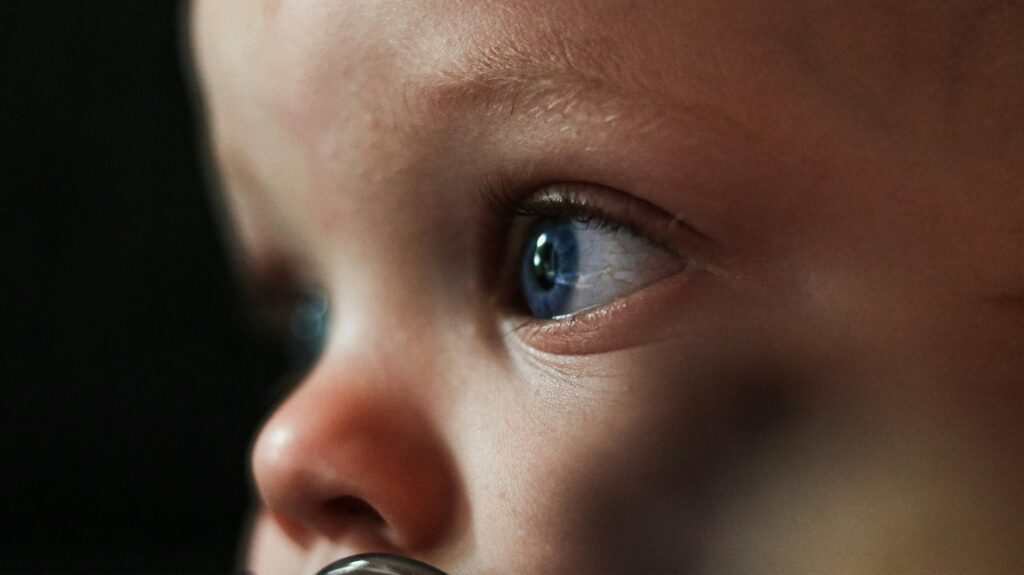If you see your baby’s eye is watery or sticky, you might feel worried about a blocked tear duct in babies. You are not the only one—about 20% of newborns get this in their first year. Most cases get better on their own without a doctor’s help.
Before you try any care at home, keep these things in mind:
- You want to know if gentle massage can help.
- You want to stop infection and keep your baby safe.
- You wonder when you should see a doctor.
Good hygiene and watching your baby closely help a lot. Most importantly, trust yourself—if you are not sure, it is always fine to ask your healthcare provider.
Key Takeaways
- Use a warm compress and gentle tear duct massage. This can help clear your baby’s blocked tear duct at home.
- Keep your baby’s eye area clean. Wash your hands before touching their face. Wipe away any discharge carefully. This helps stop infection.
- Look for signs of infection like redness or swelling. Thick yellow discharge is also a sign. Call your doctor if you see these signs.
- Most blocked tear ducts get better on their own. This usually happens by your baby’s first birthday with home care.
- Trust your feelings and ask a doctor for help if things get worse. Get medical advice if symptoms last more than 12 months. This keeps your baby safe.
Blocked Tear Duct in Babies: Home Remedies
If you are caring for a baby with a blocked tear duct, you probably want to know what you can do at home to help.
The good news is that most cases of blocked tear duct in babies clear up on their own within the first year. You can use a few gentle remedies to ease your baby’s discomfort and help the healing process along.
Warm Compress
A warm compress is one of the simplest and most effective ways to soothe a blocked tear duct in babies. The warmth helps loosen any blockage and encourages the duct to open naturally.
How to apply a warm compress:
- Wash your hands thoroughly with soap and water.
- Soak a clean, soft cloth or cotton ball in warm (not hot) water. Test the temperature on your wrist to make sure it feels comfortable.
- Wring out any excess water so the cloth is damp, not dripping.
- Gently place the cloth over your baby’s closed eye for about 5 minutes.
- Repeat this process three times a day, especially in the morning, afternoon, and evening.
Tip: Always check the temperature of the compress before placing it on your baby’s skin. The water should feel warm but never hot.
You might notice that after a few days of regular warm compresses, the eye looks less watery or sticky. Keep going with this routine until the symptoms improve.
Tear Duct Massage
Gentle massage can help open the membrane blocking the tear duct and encourage drainage. Many parents find this technique helpful for a blocked tear duct in babies, especially when done alongside warm compresses.
Step by step tear duct massage:
- Wash your hands well before starting.
- Use your index finger or a clean cotton swab.
- Place your finger or swab at the inner corner of your baby’s eye, right next to the side of the nose.
- Apply gentle pressure and move your finger downwards along the side of the nose. Use a smooth, sliding motion.
- Repeat this downward stroke 3 to 5 times per session.
- Do this massage two to three times a day—morning, noon, and night work well. Many parents find it easiest to do during nappy changes.
Note: Always use gentle pressure. Never press hard or use a rough motion. If you are unsure about the technique, ask your health visitor or GP to show you.
Regular massage, combined with warm compresses, can speed up recovery and reduce the risk of infection. Most babies respond well to this gentle care.
Hygiene Tips
Keeping your baby’s eye area clean is very important when dealing with a blocked tear duct in babies. Good hygiene helps prevent infection and keeps your baby comfortable.
- Always wash your hands before and after touching your baby’s face or eyes.
- Use a clean gauze pad or cotton ball for each wipe. Never reuse the same cloth or pad on both eyes.
- Wipe away any discharge by gently moving from the inner corner of the eye outward.
- If you see thick yellow or green discharge, redness, or swelling, contact your GP as these may be signs of infection.
- Avoid using breast milk, herbal drops, or any unproven home remedies on your baby’s eyes. Stick to clean water and saline if advised by your doctor.
Remember: Most cases of blocked tear duct in babies resolve naturally by their first birthday. If symptoms last longer or get worse, your doctor may suggest further treatment.
By following these simple steps, you can help your baby feel better and lower the risk of complications. Trust your instincts and reach out to your healthcare provider if you have any concerns.
Symptoms and Signs
Common Symptoms
You might notice your baby’s eye looks watery or sticky, even when they are not crying. This can be confusing at first.
Here are some signs you may see:
- Tears pooling in the corner of the eye
- Tears running down the cheek, even without crying
- Mucus or yellowish discharge in the eye
- Crusting along the eyelid, sometimes sealing it shut
- Redness on the skin around the eye from rubbing
- Symptoms that get worse in cold or windy weather
- Eye usually not red or swollen unless there is an infection
These symptoms often start soon after birth, usually within the first month. Most babies do not seem bothered by the extra tears. You may see the discharge more in the morning or after naps.
Tip: If you see thick yellow or green discharge, or if the eyelid looks red and swollen, your baby might have an infection. It’s best to speak to your GP if this happens.
Here’s a quick look at how symptoms can differ by age:
| Age Group | Symptoms |
|---|---|
| Infants (newborn to 6m) | Continual tearing, thick or sticky tears, crusting, white or yellow discharge, eyelids may stick shut, possible infection signs |
| Older Children | Constant watering, pus like drainage, recurrent infections, eyelids stuck shut in the morning |
Redness and swelling are not common unless there is an infection.
How to Confirm
You can often spot a blocked tear duct by watching your baby closely. The eyes usually look normal in size, and the corneas stay clear and bright.
Your baby does not seem to mind bright light and is not in pain. The main clues are the watery eyes and the sticky discharge.
If you gently wipe away the tears and the eye keeps watering, this points to a blocked duct. Try a gentle tear duct massage by pressing and sliding your finger down the side of the nose. If the symptoms improve, this supports your suspicion.
Other eye problems, like congenital glaucoma, look different. Babies with glaucoma may have large eyes, cloudy corneas, and dislike bright light. They may seem upset or in pain. If you notice these signs, or if symptoms last beyond nine months, you should see your GP for advice.
Note: Most cases clear up on their own by the time your baby turns one. If you are ever unsure, trust your instincts and ask your healthcare provider.
When to See a Doctor
Warning Signs
Sometimes, you need to act quickly if your baby’s eye looks worse or you spot certain changes. These warning signs mean you should contact your doctor right away:
- Redness or swelling at the inner corner of the eye, especially if the swelling is the size of a pea or bigger.
- Thick yellow green discharge that comes back soon after you wipe it away.
- Fever over 38 °C (100.4 °F), especially if your baby is younger than three months.
- Your baby keeps rubbing the eye or refuses to open it, which can mean pain or irritation.
- Red streaks on the skin spreading from the eye towards the cheek or nose.
- The white part of the eye looks cloudy or hazy.
- The eye looks like it is bulging out.
Alert: If you see any of these signs, do not wait. These symptoms can point to an infection or a more serious problem. Your baby may need urgent care.
You might wonder what could happen if you leave a blocked tear duct untreated. Here’s a quick look at possible complications:
| Complication | Description |
|---|---|
| Dacryocystitis | Infection of the tear sac, causing a bump near the nose. Needs antibiotics. |
| Conjunctivitis | Higher risk of eye infection due to the blockage. |
| Spread of Infection | Infection can move to the eyelids or sinuses if not treated. |
Persistent Symptoms
Most blocked tear ducts in babies clear up by the time your child turns one. Over 90% open on their own. You can keep using home care if your baby is under 12 months and there are no signs of infection.
Here’s when you should seek medical advice:
- Your child is older than 12 months and the tear duct is still blocked.
- You notice a red lump, pus, or mild swelling of the eyelid—call your doctor within 24 hours.
- Severe redness, swelling, cloudy cornea, or fever appear—get help straight away.
- Your baby seems very unwell or the symptoms get worse quickly.
Tip: If you ever feel unsure, trust your instincts. It is always better to check with your GP than to wait and worry.
You can help your little one by following a few simple steps at home. Use a warm, damp cloth on the eye, clean away any discharge, and gently massage the tear duct as shown by your doctor.
Keep your hands and your baby’s face clean to prevent infection. Most cases of blocked tear duct in babies clear up on their own within the first year.
If you notice redness, swelling, or your baby seems unwell, contact your GP. Trust your instincts—your care makes a real difference.
FAQ
What causes a blocked tear duct in babies?
A blocked tear duct often happens because the duct did not open fully at birth. You did nothing wrong. This is very common in newborns and usually gets better as your baby grows.
Can I use breast milk to treat my baby’s eye?
You should not use breast milk or any home remedy in your baby’s eye. Stick to clean water and the steps your doctor recommends. Using unproven treatments can cause infection.
How long does it take for a blocked tear duct to clear?
Most blocked tear ducts clear up by your baby’s first birthday. You may see improvement in a few weeks with gentle care. If the problem lasts longer, speak to your GP.
Is a blocked tear duct painful for my baby?
A blocked tear duct usually does not hurt your baby. You might see extra tears or sticky discharge, but most babies do not feel pain. If your baby seems uncomfortable, check for infection and contact your doctor.
Can a blocked tear duct come back after it clears?
It is rare, but sometimes the blockage returns. If you notice watery eyes or discharge again, repeat the gentle care steps. If symptoms keep coming back, your GP can help.



